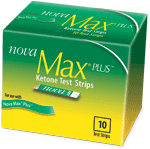Summer brings to mind sunny days and warm weather but it can also be a time when storms occur. It is important to be prepared for a storm when you have diabetes. Emergency services can take longer to arrive during storms and it is better to be ready.
- Know what you need to prepare for emergency supplies at work, home, school and the car. These locations should have an emergency kit that contains water, first-aid supplies and non–perishable foods as well as medicines and diabetes care needs. Other items to have in an emergency kit are personal hygiene basics, communication devices and sources of shelter, warmth and light. Keep similar supplies in a “go bag” at home so you can quickly take it if you need to leave in an emergency. Have at least three- seven days of emergency supplies on hand. Check your emergency kits and bag at least once a year to replenish expired items. Make sure your school and workplace have a plan for emergencies.
Emergency kits should contain at least three-seven days of diabetes supplies and you should have a one-week supply in your home bag. If a medicine must be kept cool, store it in your refrigerator at home or work. Supplies to include in your storm kit include syringes, extra insulin and an extra glucose meter. Also have test strips, insulin pump supplies, lancets and a lancing device as well as a glucagon kit (Type 1 Diabetes) and ketone test strips. Other items to include are extra batteries for your blood glucose pump and meter, glucose tablets or gel and alcohol wipes. Insulin should be kept cool during power outages so consider investing in an evaporative cooler which is activated by water and keeps insulin cool up to two days. Other options are an insulated lunchbox or bag with ice, frozen food or a cold pack from the freezer. Insulin should never be placed directly on the frozen source.
- Besides diabetes supplies, your emergency kit should have copies of your insurance card, all your prescriptions including contact lenses or glasses. Write down a dosage chart in case others need to administer medicines to you. Pump users should include insulin-to-carbohydrate ratios, basal rates and correction factors. If you subscribe to a medical emergency service plan print out all the essential information and place it in a Ziploc baggie. Include the contact information for your doctor.
- Minor injuries and skin infections can quickly become disastrous for people with diabetes. Have a fully-equipped first aid kit with adhesive bandages of different sizes, gauze roll bandages and a larger sterile dressing. Include elastic bandages and antibacterial hand wipes. Pack antiseptic wipes for cleaning wounds, square sterile gauze pads and adhesive tape along with antibacterial ointment and a few pairs of latex gloves. Other items to include are scissors, cold packs, skin care lotion and tweezers. Think about having a CPR breathing barrier mask as well. Collect a few OTC medicines such as aspirin, antacids and throat lozenges. Review your first aid kit each year to replace expired items.
- There are other items to consider for emergencies. Keep canned goods that can be eaten cold and a manual can opener to open them. Pack flashlights, lanterns and a battery powered, hand-cranked radio along with extra batteries. Gas up your generators and vehicles. Keep plenty of dry goods on hand including packaged crackers and toilet paper. Invest in a good supply of bottled water that does not expire for up to five years. Have cell phones and mobile computing devices fully charged so you can reach out during emergencies. Tuck away extra cash for emergency use if the ATM’s are out of service. Have a tarp for emergency shelter and blankets to keep warm. Store extra ice cubes and cold packs in your freezer to keep foods and insulin cold if the power goes out.
From a simple power outage to a major storm, the event becomes more catastrophic when you’re unprepared. It makes a big difference to have adequate supplies of water, food and ways to remain cool, dry or warm. Be ready with diabetes care items. This makes it possible to survive the storm more comfortably and stay in good health while doing it.













Leave A Comment